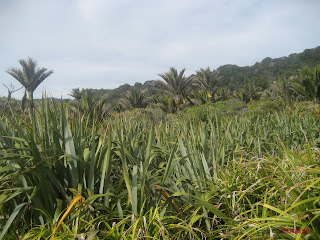It seems like every guide book, information booklet, and website that I looked at had a picture of Pancake Rocks. It was a definite "do not miss when visiting the West Coast of New Zealand". We don't usually plan our trips to around the "must-sees," but we were drawn by the description of Paparoa National Park: 30,000 hectares of varied landscape from lush West Coast native rainforest and mountain tops, to expansive rugged beaches and coastline. We hoped to find a National Park where we could camp in a natural environment for several days and hit the trails. You can imagine our disappointment when we learned that there were no DOC campgrounds and that there were a limited number of trails.
We had a choice of doing a quick walk around Pancake Rocks and the Blowholes--with the hundreds of other tourists--or of checking into the privately run caravan park and do some further exploration on one of the longer tracks. We chose the later and headed down to the Punakaiki Beach Camp. The caravan park does not have beach views, but you can hear the lull of the waves. It is also conveniently located next to the Punakaiki-Pororari Loop trailhead; this 11 km loop turned out to be a highlight of our visit.

The trek starts by following the meandering Pororari River, which over thousands of years has carved a spectacular gorge. Tall limestone cliffs dramatically drop to the boulder-strewn riverbed. Without the broad, maintained, man-made path the forest would be impenetrable. We were surrounded by a countless number of trees, bushes, mosses, lichens, and epiphytes. Each species of plant fights for its own space to grow. Layer upon layer--with its vibrant, multi-hued greens--the dense vegetation creates a visual mosaic.
We didn't need to be told that we were walking through a sub-tropical forest. We felt it in the thickness of the air. Each deep breath brought a heavy wetness into our lungs. Our clothes quickly became drenched with our sweat. The river and its deep pools looked inviting, but we had to carry on if we were to complete the loop before nightfall.
The track slowly narrowed and the gradients became steeper as I walked inland. The trail became rocky and slippery, and I had to carefully place each step. After about 3.5 km we merged with the Inland Pack Track. Here we began a gradual ascent over a small ridge. With each stride the suffocating air became thinner and cooler. It no longer felt as though I were drinking each breath. Sweat ceased gathering on my body; instead it seeped from my pours since I had increased my physical exertion to climb the hill.
As we left the river valley and entered a temperate rain forest, there continued to be abundant vegetation, but there was a less crowded feeling. The hills are brimming with trees, but they are taller and there is more space between them.
When we crested the ridge we had hoped to catch a glimpse of the rocky coastline. Unfortunately, our view was blocked. We dropped into a second valley where we were forced to ford the Punakaiki River. I am not a fan of water, so this was not something that I was looking forward to. The water was not fast moving nor too deep. However, due to the very rocky bottom we decided to keep on our boots. Besides, when reading about tramping in New Zealand we read that only novice walkers remove their shoes for river crossings. Moments into the crossing, the cold water rushed over the top of my boots and my feet became soaked. The river which appeared to be slow moving from the banks, flexed its power as it rushed passed my calves. It took my full concentration to not be knocked off my feet. After what seemed like an eternity I finally reached the other side. A squeal of delight escaped my lips. I felt so exhilarated. As I squished down the dirt road any discomfort I felt was replaced by a feeling of satisfaction, another hiking milestone had been crossed.

































